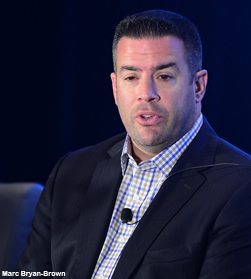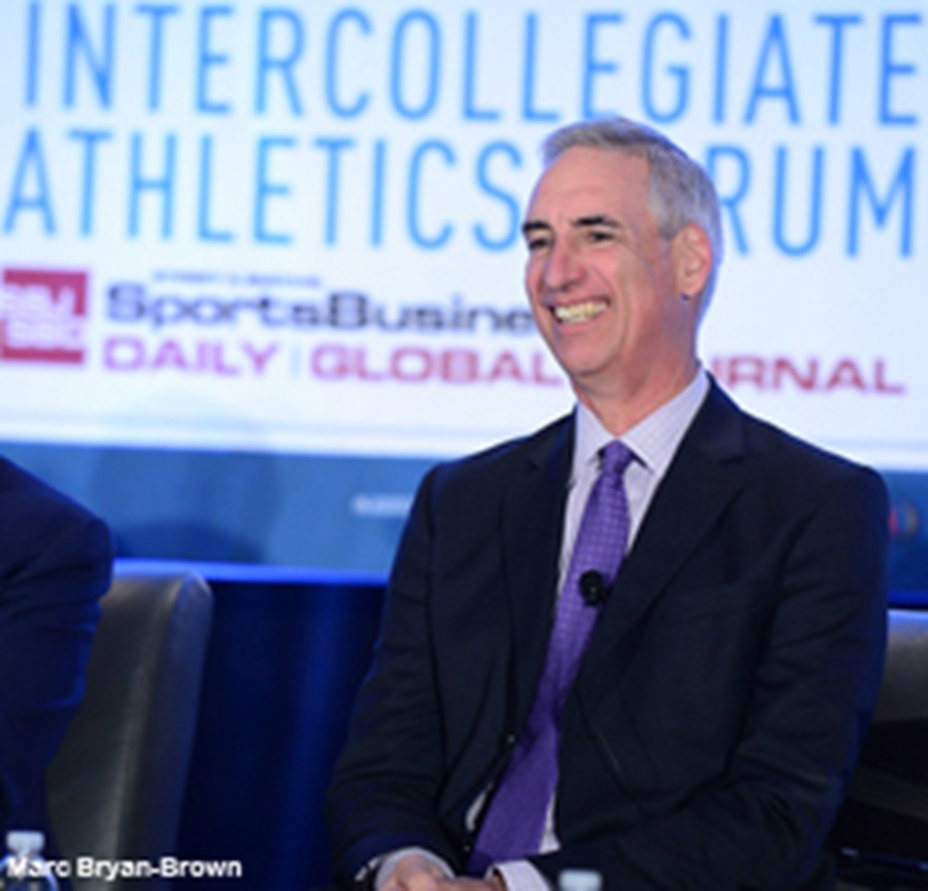Spending on college campuses is largely handled responsibly by today’s ADs, but there are pressures that cause some institutions to push for more, according to a panel of leading college execs at the '15 IMG Intercollegiate Athletics Forum. When asked by SBJ college writer Michael Smith whether athletic spending is out of control, NCAA Exec VP/Regulatory Affairs Oliver Luck said, “I’m not sure it’s out of control. ... As a former athletic director, we have all these projects going on, but these are responsible projects. Do we have to get every bang for our buck? Sure.” He added, “I’m not sure there is any real crisis in spending, but certainly we can do a better job getting bang for the buck. ... The vast majority of these decisions are based on what these campuses need. ... There are a lot of eyeballs on these projects, which leads me to believe they are responsible projects at the end of the day.”
 |
Pernetti said the challenge on spending is toeing
the line between functional and fascinating projects |
ARMS RACE? American Athletic Conference Commissioner Mike Aresco said, “There is probably some spending that is probably over the top. ... I don’t think you need to have Taj Mahal’s everywhere. Much more important is how smart you are in spending your money. I think you attract good student athletes by the type of coaches you have. The spending, most of it, is reasonably responsible.” IMG College President of Multimedia Tim Pernetti reflected on his tenure at Rutgers by saying, “There was never a project that we studied or put forth that wasn’t being done with probably too many chefs in the kitchen. Everyone was involved and nothing gets done unilaterally. I think the challenge on the spending is there is a line between functional and fascinating. And everyone is going for the ‘wow’ factor for recruiting, everybody is trying to find something nicer, brighter, that is a big difference. ... Our goal at Rutgers was to make buildings nice and functional, to make the experience for student-athletes better. But there is a line there, and if you can afford to push the line a little bit, and if you can push it to make something look better and nicer than someone else's, people will do it.”
SPENDING WISELY: Smith asked the panel about a widespread perception that ADs are using too much of their time on spending and expenditures. Luck dismissed that, calling it “not legitimate.” Luck: “I don’t see that much completely wasteful spending. Sure, somewhere in the system you can save some dollars, but I think most ADs are pretty focused on making sure that money is being spent responsibly. There are many eyes looking at that budget.” Pernetti agreed: “Every dollar, especially at a state school, that you spend is scrutinized. ... I don’t think anything is being done irresponsibly.” Learfield Sports’ Greg Brown also rejected the notion that ADs are spending irresponsibly, saying, “Schools are identifying targets that they need to improve or develop and then they go out and raise that revenue to support their initiative. They aren’t sitting on a pot of gold and then trying to find the way to spend that revenue. The reverse is true.” Aresco agreed that ADs are acting responsibly, but he added, “The problem is, the more money you have, the more projects you want to embark on. You want it to be your legacy and the legacy of your school. There is nothing wrong with that. The question becomes, what goes beyond what you absolutely need to satisfy your alumni, community and student athletes.”
FOOD FOR THOUGHT: Luck also took exception to a question about whether nutritional deregulation and food service for athletes is becoming an “arms race.” Luck: “I would take a bit of an issue with that. Basically, we are trying to feed kids who are busy, trying to get to class, trying to get to a film session or a practice. Maybe they are grabbing a sandwich. I’ve yet to see pheasant under glass at any institution. We are talking grab-and-go stations. That’s probably something that was a necessity. The worse thing in the world is for a kid to go to a practice who is not healthily nourished. There is probably a safety concern. I would not go as far as to say nutrition is the new arms race. I think it’s a responsible thing to do for our kids.” Pernetti agreed: “That’s a necessity, and if you’re not doing it, you’re doing a disservice to your athletes.”
PERNETTI OUTAKES: Pernetti was blunt when asked about athletic departments being subsidized by other departments on campus. Among his comments:
* “There is always going to be the friction between the athletic side of the house and the academic side of the house. But there is no stronger marketing arm in college than athletics. Done the right way, it can be the strongest marketing you have, nothing compares to it. If things go haywire on you, and I lived through that, it can also have the opposite effect. So, the spending, I don’t think is out of control, and I don’t think it’s stopping any time soon.”
* “I would have people come up to me at Rutgers and say, ‘You’re over-commercializing athletics!’ I would say, ‘It doesn’t cost zero to open this gate and run this football game. There has to be a commercial business attached to do what we do in order to be able to function.’”
* “I remember having a conversation with a professor who told me, ‘There is too much emphasis on athletics at Rutgers.’ I said, ‘Well, if you can put 50,000 people in a stadium to hear a lecture every week, I’ll look at that. But otherwise take a hard look at the value this brings.’ Being on ESPN every week, the branding, the visibility. When athletics is successful, applications are up, admissions are up, the visibility of the university is up.’ So if there is a subsidy that can be made that is reasonable, it should be made because the university gets that back ten-fold.”





